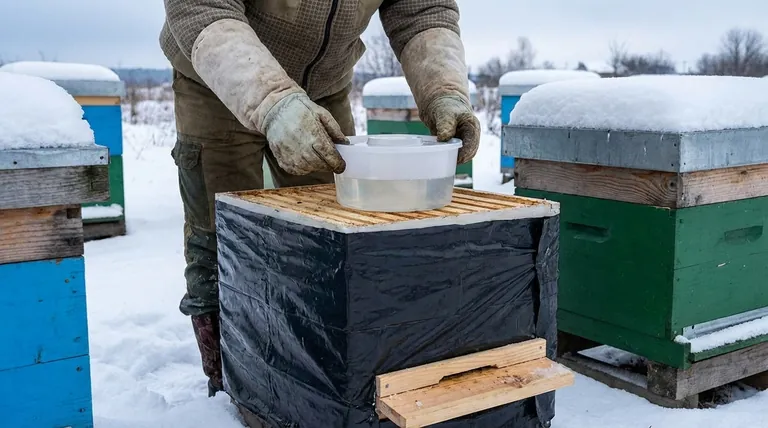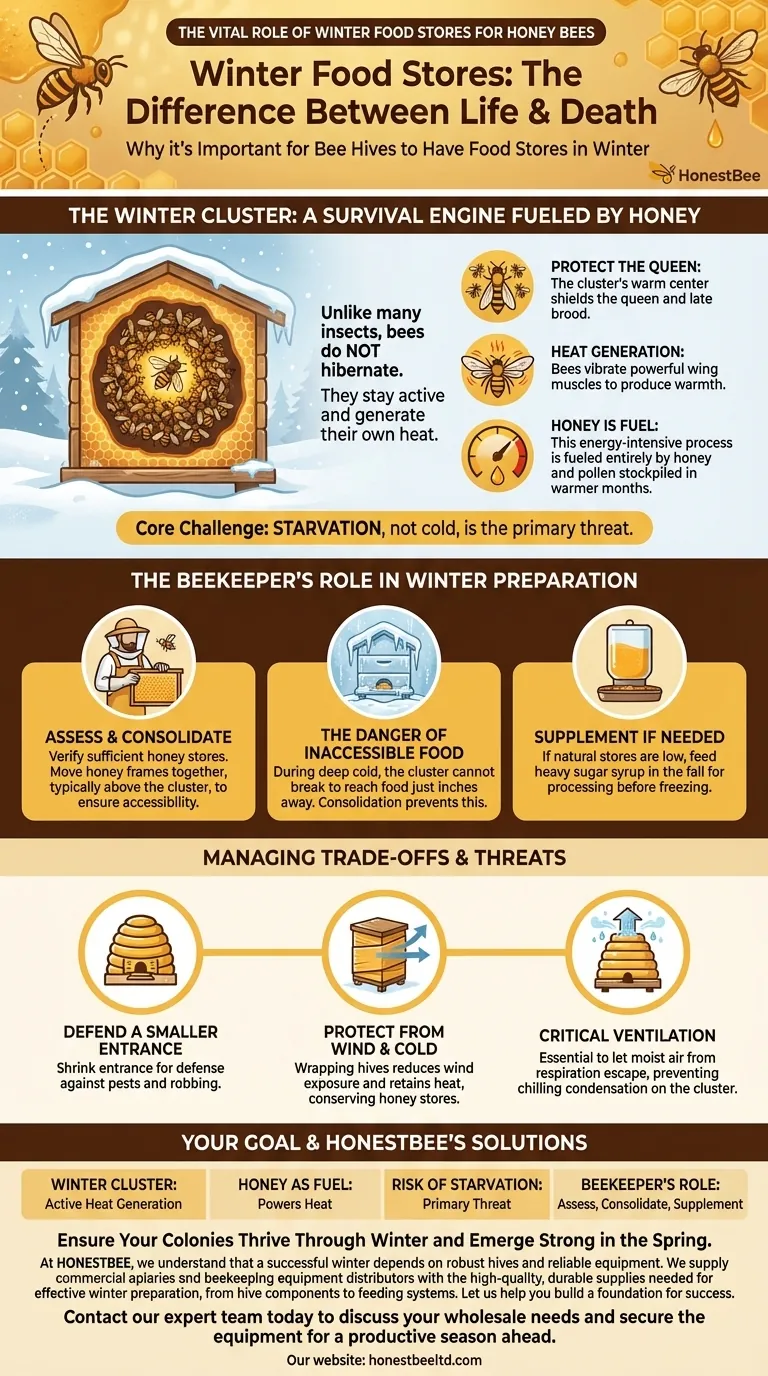For a honey bee colony, winter food stores are the sole difference between life and death. Unlike many other insects, bees do not hibernate. Instead, they remain active inside the hive, generating their own heat, and this energy-intensive process is fueled entirely by the honey and pollen they stockpiled during the warmer months.
The core challenge for a beehive in winter is not the cold itself, but the risk of starvation. A colony's survival depends on having a sufficient and accessible supply of honey to fuel the "winter cluster" that actively generates heat until foraging is possible again in the spring.

The Winter Cluster: A Survival Engine Fueled by Honey
To understand the critical nature of food stores, you must first understand how a honey bee colony functions in the cold. They do not passively endure winter; they actively fight it.
Why Bees Don't Hibernate
Honey bees form a tight ball known as a winter cluster. The queen is protected in the warm center, while the outer layer of bees acts as a living blanket of insulation.
Generating Heat Requires Energy
Bees on the inside of the cluster vibrate their powerful wing muscles, a process that generates significant heat. This muscular activity keeps the center of the cluster warm, protecting the queen and any late-season brood from freezing.
Honey as High-Octane Fuel
This constant heat generation is incredibly demanding. Honey is the carbohydrate-rich fuel that powers this muscular activity. Without a continuous supply, the cluster cannot generate heat, and the colony will quickly perish.
The Beekeeper's Role in Winter Preparation
A beekeeper's primary responsibility in the fall is to ensure their colonies are prepared for the long, dormant period ahead. This preparation centers on food.
Assessing and Consolidating Stores
Starvation is a leading cause of colony death in winter. Before the cold sets in, a beekeeper must verify the hive has enough honey. It is also crucial to move all the honey frames together, typically above the cluster.
The Danger of Inaccessible Food
During deep cold snaps, the cluster of bees can become too chilled to move. A colony can starve to death just inches away from honey if they cannot break cluster to reach it. Consolidating food stores prevents this tragic scenario.
When to Supplement with Syrup
If a colony's natural stores are insufficient, the beekeeper must intervene. This is typically done by feeding the bees a heavy sugar syrup in the fall, giving them enough time to process and store it before temperatures drop too low.
Understanding the Trade-offs and Other Threats
While food is the primary concern, a successful overwintering strategy addresses several interconnected factors. A beekeeper's choices involve managing a delicate balance.
Defending a Smaller Entrance
As the colony's population shrinks for winter, its large summer entrance becomes a defensive liability. A beekeeper installs an entrance reducer to give the bees a smaller, more defensible opening against pests and robbing insects.
Protecting Against Wind and Cold
Wrapping hives in materials like black plastic can reduce wind exposure and help retain heat. This lessens the energy burden on the bees, allowing them to conserve their precious honey stores for longer.
The Critical Need for Ventilation
A hive wrap or a sealed-up hive can trap moisture produced by the bees' respiration. This moisture can condense, drip down onto the cluster, and chill the bees. Proper ventilation, often through a small upper entrance, is essential to let this moist air escape.
Making the Right Choice for Your Goal
Your approach to winter preparation depends on your goal, but it always revolves around ensuring the colony has the resources it needs to survive.
- If your primary focus is basic survival: Confirm the hive has ample, consolidated honey stores before the first hard frost.
- If your primary focus is optimal colony health: Supplement food stores while also managing ventilation, reducing the entrance, and providing wind protection.
- If your primary focus is a strong start next season: Remember that a healthy, well-fed colony in winter emerges faster and more productive in the spring.
Properly managing winter food stores isn't just about preventing starvation; it's about setting the stage for a thriving colony in the spring.
Summary Table:
| Key Factor | Why It Matters for Winter Survival |
|---|---|
| Winter Cluster | Bees remain active, generating heat to survive the cold. |
| Honey as Fuel | Powers the energy-intensive heat generation process. |
| Risk of Starvation | Primary cause of colony death; food must be accessible. |
| Beekeeper's Role | Assess stores, consolidate frames, and supplement if needed. |
Ensure your colonies thrive through winter and emerge strong in the spring.
At HONESTBEE, we understand that a successful winter depends on robust hives and reliable equipment. We supply commercial apiaries and beekeeping equipment distributors with the high-quality, durable supplies needed for effective winter preparation, from hive components to feeding systems.
Let us help you build a foundation for success. Contact our expert team today to discuss your wholesale needs and secure the equipment for a productive season ahead.
Visual Guide

Related Products
- Rapid Bee Feeder White Plastic 2L Round Top Feeder for 8 or 10-Frame Bee Hives
- HONESTBEE Round Hive Top Bee Feeder for Syrup
- Professional Hive Top Bee Feeder for Beekeeping
- Classic Boardman Entrance Bee Feeder Hive Front Feeding Solution
- HONESTBEE Entrance Bee Feeder Professional Hive Nutrition Solution for Beekeeping
People Also Ask
- What can the round hive top feeder be used for? A Guide to Efficient, Safe Bee Feeding
- What is the advice regarding feeding bees to limit brood production based on? Managing Prolific Bee Strains
- Can sugar syrup contaminate the honey crop? A Beekeeper's Guide to Protecting Honey Purity
- How much honey does a strong hive need to survive winter? Ensure Your Colony's Survival (60-80 lbs)
- What is the best thing to feed bees? A Guide to Supplemental Feeding for a Thriving Hive



















